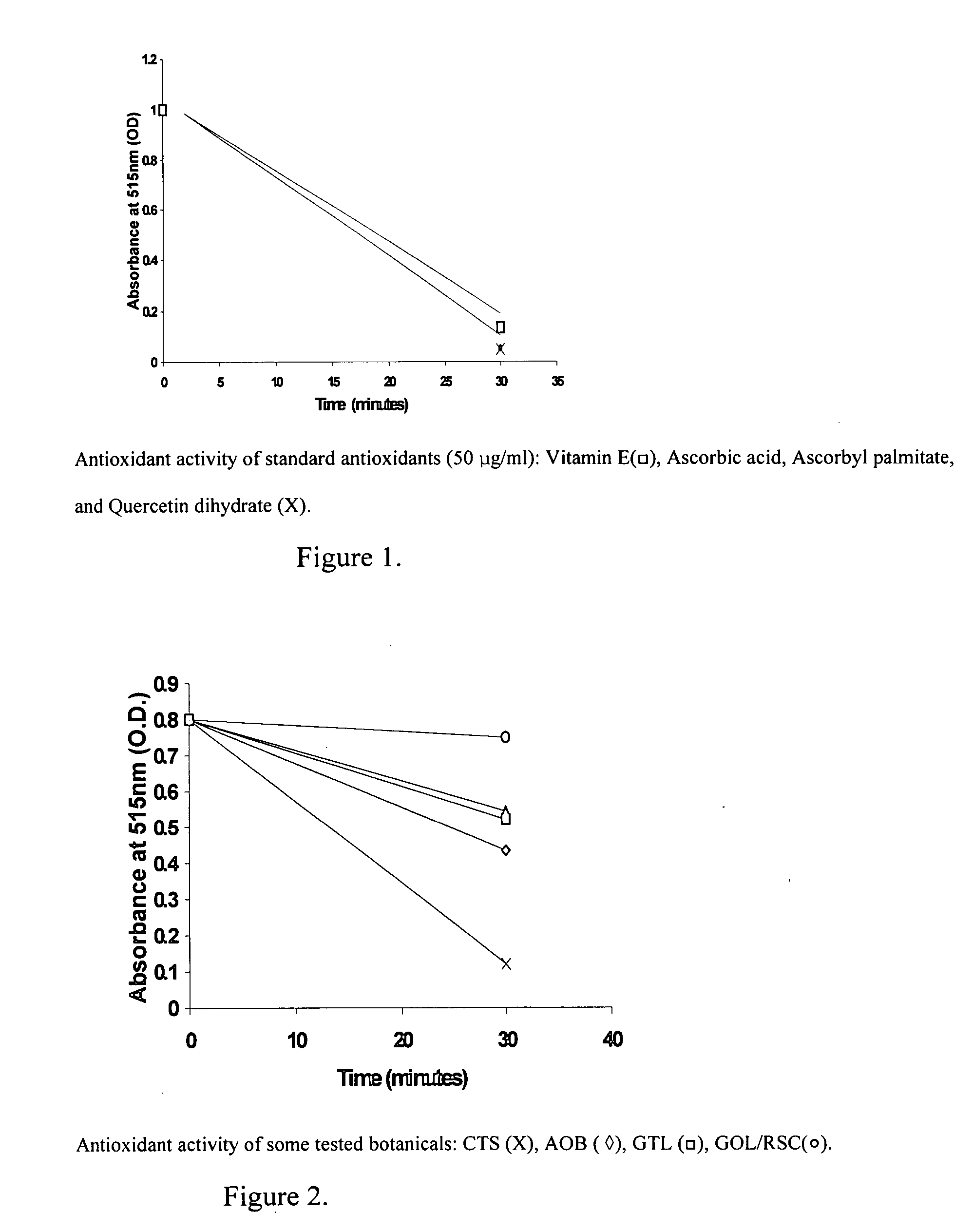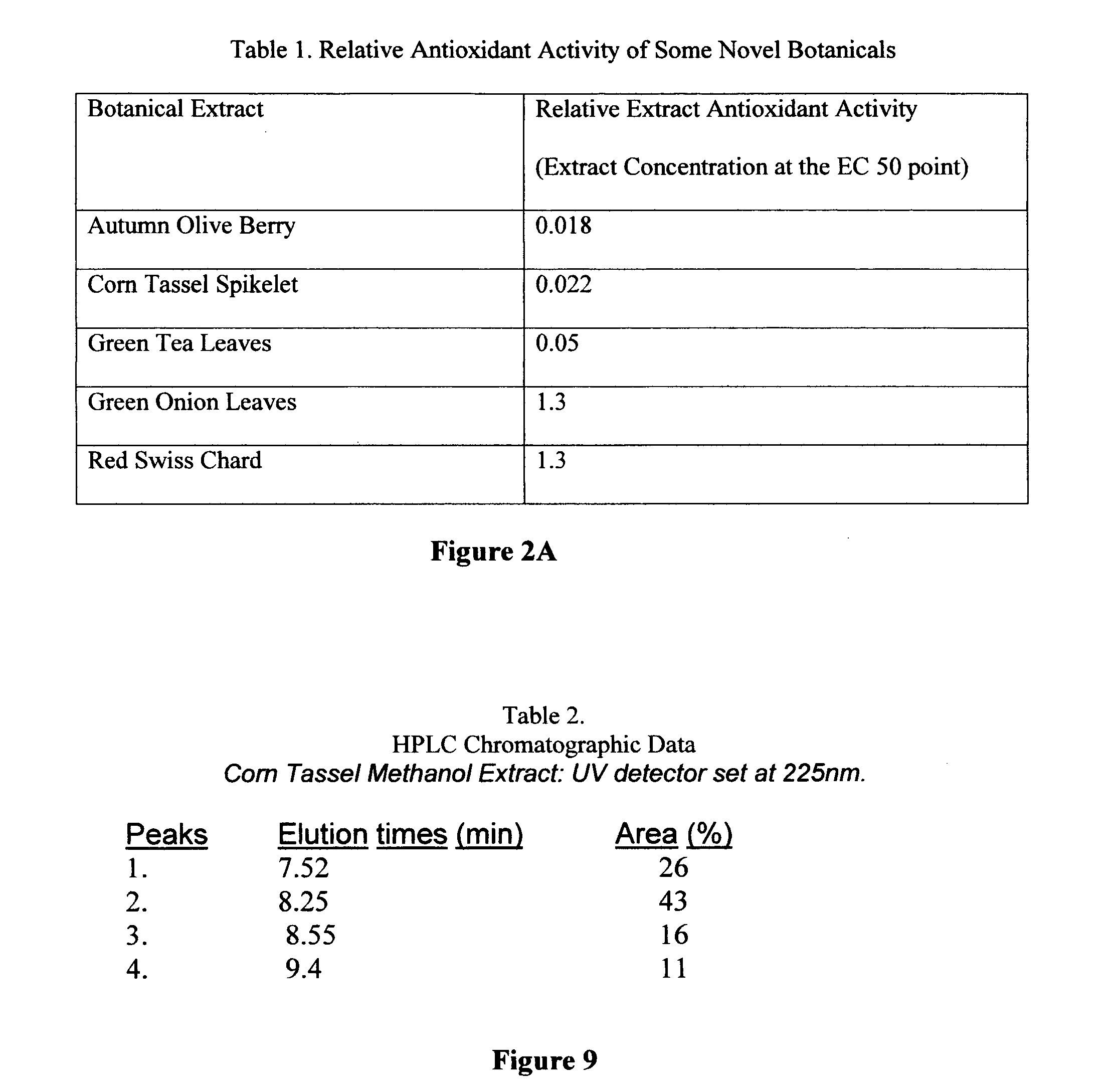Novel anti-irritant botanicals
- Summary
- Abstract
- Description
- Claims
- Application Information
AI Technical Summary
Benefits of technology
Problems solved by technology
Method used
Image
Examples
example 1
Preparation and Antioxidant Activity of Botanical Extracts
Botanical Extraction:
[0049] An equal volume of ice-cold 95% alcohol was added to 100 grams of either dried or wet weight (w / v) of minced plant material and the mixture blended at 23° C. for 2 minutes. The homogenate was clarified by low speed centrifugation at 5° C. and sterile filtered through (0.45 micron filter). All hydroalcoholic extracts so prepared were stored at 0-4° C. and protected from light until further use. Extract concentration was calculated using the percent weight of botanical material to the total volume of botanical weight plus extraction volume. This was 36% (w / v) for Autumn Olive berries (AOB), 5% f (w / v) for Corn Tassel Spikelets (CTS), 11% (w / v) for dried Green Tea Leaves (GTL), 37% (w / v) for Green Onion leaves (GOL), and 36% (w / v) for Red Swiss Chard (RSC, 36% wet weight).
Anti-Oxidant Assay:
[0050] Aliquots of botanical hydroalcoholic extracts were assayed for their antioxidant activity by the di...
example 2
Use of Retinoid-Stimulated Autocrine(RSA) Growth Assay for Detection of Plant Extracts with Putative Anti-Irritant Activity
[0054] Since retinoids irritate skin leading to epidermal hyperplasia, it is the inventors idea that plant extracts that act as inhibitors of retinoid -stimulated autocrine growth are themselves anti-irritants. This hypothesis was tested using an in vitro keratinocyte culture model.
[0055] An immortalized line of human epidermal kertatinocytes, HaCat keratinocytes, can be cultured in a serum-free culture medium. Sterile Petri dishes (35 mm2) are seeded at 5,000 cells per cm2 and placed in a humidified CO2 incubator at 37° C. for 3-5 days or until the culture reaches about 30% confluent monolayer growth. The dishes are washed once with ice-cold serum-free media lacking EGF and insulin, and refed 2.5 ml of serum-free culture medium containing 5 ug / ml insulin and retinyl acetate (RA, 3×10−8 M).—Duplicate control dishes are fixed and stained with 0.2% crystal viole...
example 3
Anti-Irritant Activity of Botanical Extracts
Anti-Irritant Assays.
[0060] All carrier system gels were prepared with 0.5% benzalkonium chloride, a mild irritant. To test for anti-irritancy, the irritant-containing carrier gels were also loaded with the test botanical extracts (experimentals). The control and test gels were deposited (100 microliters) on 10 mm square circular filter paper discs and placed in side of Finn chambers (20 mm square), which were then applied to the volar arm skin of volunteers. The chambers were affixed to skin with non-allergic adhesive tape and left in place for 24 hours. Upon termination of the treatments, the chambers were removed and the skin gently wiped clean with moistened cotton swabs. The exposed skin was first examined for signs of erythema (redness) and induration (swelling), and skin sites photographed. The exposed skin sites were probed for skin capacitance (skin moisture levels) using a Corneometer instrument (Courage & Khazaka, Koln, Germa...
PUM
 Login to View More
Login to View More Abstract
Description
Claims
Application Information
 Login to View More
Login to View More - R&D
- Intellectual Property
- Life Sciences
- Materials
- Tech Scout
- Unparalleled Data Quality
- Higher Quality Content
- 60% Fewer Hallucinations
Browse by: Latest US Patents, China's latest patents, Technical Efficacy Thesaurus, Application Domain, Technology Topic, Popular Technical Reports.
© 2025 PatSnap. All rights reserved.Legal|Privacy policy|Modern Slavery Act Transparency Statement|Sitemap|About US| Contact US: help@patsnap.com



